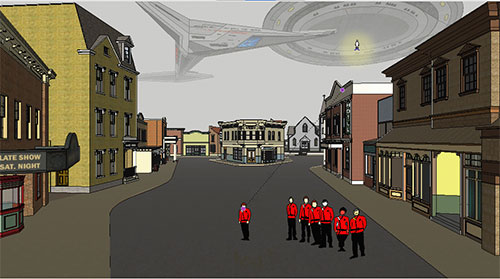Manage your objects: All primary geometries are formed and attributed to layer 0. In order to manipulate their perceptibility the geometries should be created as a group or component and attributed to a particular layer.
Name your groups and components: There should be proper title for groups and components as well as IFC so that these can perform easily with outliner, LayOut and BIM.
Working with materials: All materials must be assigned to faces. If the materials are used with group, the groups deafault colored faces will be replaced with selected color and the users will be unable to modify the coordinates of the texture. Every material should require a distinctive and logical name and the maximum essential texture size.
Inserting Objects: CAD data and 3D Warehouse models must included in a new sketchup model. But before inclusion to the working files, their scale should be verfied properly and unessential layers and geometries should be eliminated.
Working with complex models: While dealing with complicated models, seperate parts of the model must be created in a new sketchup file and then amassed or referenced in the working files like a component.
Keep it simple: Don't use redundant arc and circle segment count so that the size of the model can be reduced. Don't model parts which will be invisible in the final output.
Model with solids: You can apply and adjust your objects conviently, if the objects are generated as solids. In order to perform a quicker workflow, learn the application of solid tools. Try to make the front faces of the object outside to apply the stylistic effects easily as well as make the rendering process troubfree.
Use Scenes to improve workflow: In order to get quicker performance and workflow at the time of modeling, apply scenes to manage layer, shadow, fog and clear stylistic effect and settings. Besides, the users can avail free up viewport space out of dialog boxes and toolbars.
Use components: Apply components above groups when necessary for decreasing the file size, facilitating smooth editing as well as utilize objects more resiliently.
Model Maintenance: The file sizes of sketchup are increased and the performance is affected as the assigned components, materials and styles are still included in the sketchup file after being erased and leftover in the scene. To get rid of the issue, apply purge unused or the cleanup plugin to delete unnecessary edges and merge faces on a regular basis.
Presenting design: Apply scenes to navigate amid views, show section, cut and shadow study animations and manage the clarity of layer. The scenes can also be applied in sketchup viewers and embedded 3d warehouse windows. Crete slide presentations in Layout to support the sketchup presentation. While dealing with complicated models, always deactivate the auto-save option so that the performance can''t be disrupted.
Sharing models: Befor delivering any sketchup file to others, always check the version of sketchup being used by them. It becomes difficult to open newer version files in earlier version of sketchup.
Using scenes from 3d warehouse models: If it is necessary to apply the scenes out of 3d warehouse models, just open them individually rather than opening them in your working files like a component.
Saving your model: Apply save a copy as option in place of save as to preserve the name of original file while taking backups on daily basis.
Camera Clipping: Try to create model adjacent to axis origin to get rid of the issue like camera clipping. Clipping may happen while dealing in parallel projection mode as well as if some geometry is situated remotely from axis origin.
Face flickering: To solve the issues like face flickering or z-fighting, raise up/erase or conceal one of the faces situated on the identical plane.
Cursor trails: If cursor trails are visible while dealing with bigger models, just deactivate fast feedback in the OpenGL preferences or revise your video card drivers.
Disappearing faces: To resove face-creating issues, try to model very small objects in a larger scale.
Backface color bleeding: Backface colors may visible at the object profile edges, if the models are exposed devoid of edges. This effect can be reduced by modifying the color of the backfaces.
 |
| Image Courtesy: sketchupdate.blogspot.com |
~~~~~~~~~~~~~~~~~~~~~~~
Published By
Rajib Dey
~~~~~~~~~~~~~~~~~~~~~~~
No comments:
Post a Comment